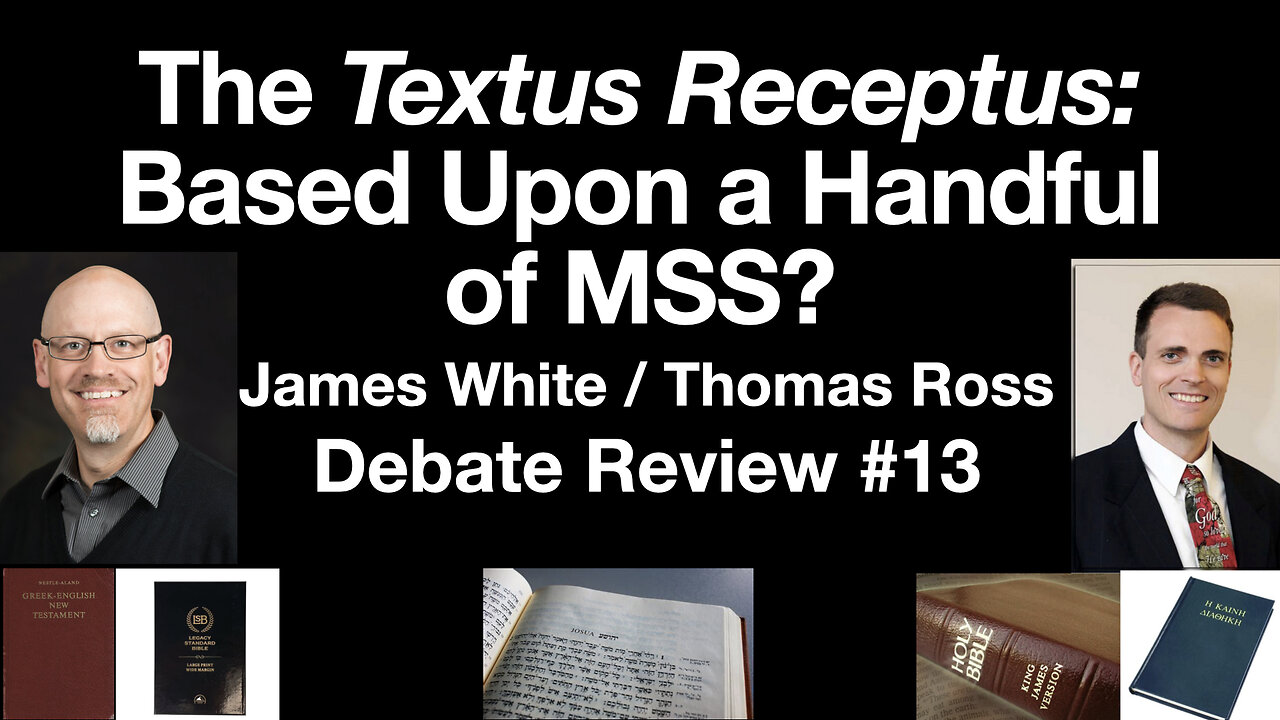Premium Only Content

Are the Textus Receptus & KJV Based Upon a Handful of Manuscripts? James White / TR Debate Review 13
James White asserted that modern versions like the Legacy Standard Bible “utiliz[e] far, far more manuscript evidence than was even dreamed of by the KJV translators" while the King James Version and Textus Receptus are “based upon a handful of manuscripts.” Indeed, James R. White claimed that the LSB had “access to manuscripts a solid 1800 to 1200 years older than those used by Erasmus for … the New Testament.” These claims of Reformed evangelical apologist James White, from his King James Only debate with Thomas Ross, are examined in this debate review and in debate review video #14.
Dr. White and Dr. Ross debated the topic: “The Legacy Standard Bible, as a representative of modern English translations based upon the UBS/NA text, is superior to the KJV, as a representative of TR-based Bible translations" at the Covenant Reformed Baptist Church of Tullahoma, TN, USA, on February 23, 2023.
James White affirmed that the Nestle-Aland Greek Textus Rejectus and modern English Bible versions such as the Legacy Standard Bible are superior to the Textus Receptus and the King James Bible because, he claimed, modern versions and the Nestle or United Bible Society (NA/UBS) Greek text is based upon and utilizes far, far more evidence than the Textus Receptus is based upon. However, the Received Text looks far more like the Greek text that is found in the large majority of Greek manuscripts than the Nestle-Aland text, which, in truth, is based upon a handful of manuscripts, such as Aleph (Sinaiticus) and B (Vaticanus), or too often upon no manuscripts at all. Were Dr. White consistent with his own argument, he would need to acknowledge that the Received Text is superior to the modern NA/UBS text, and modern English versions based on that minority text are inferior to the TR.
Near the end of the debate, answering the audience question “Of the 5,000+ Greek manuscripts available, how many manuscripts is the NA28 based on?” James White answered: “The NA28 will use all of them,” even though the NA28 editors did not even look one time at the vast majority of Greek manuscripts, much less “use” “all” of them. One could easily get the very misleading impression from Dr. White’s answers that the Textus Rejectus is based upon the majority of Greek manuscripts and the Textus Receptus is a minority text, but this is a radically inaccurate presentation of the evidence The impression White is conveying here is exactly wrong, as in the overwhelming majority of cases where the KJV and the Received Text differ from modern versions and the Nestle-Aland text, the Nestle-Aland text follows a tiny minority of Greek manuscripts while the Received Text and the KJV follow the overwhelming majority. Someone who believes that we should follow “far, far more manuscript evidence” instead of “a handful of manuscripts” will necessarily view the LSB and modern versions based on the Nestle Aland Greek text as inferior to the KJV and the Textus Receptus. When White attacks the KJV and says we should follow “far, far more manuscript evidence” instead of “a handful of manuscripts,” the conclusion will necessarily follow that the KJV and the Textus Receptus are superior to the Nestle-Aland Greek text and the modern versions based upon it.
White’s statement about the LSB and Nestle-Aland Greek text editors and translators having “access to manuscripts a solid 1800 to 1200 years older than those used by Erasmus for … the New Testament” is self-evidently impossible. Among other manuscripts that are now lost or unknown, Erasmus used miniscule 2, written in the 1100s AD, for his 1516 edition as well as being aware of readings in the fourth century codex Vaticanus (and refusing to place them into the printed text, since it is inferior to the Received Text manuscripts); miniscule 2817, copied in the 1000s AD, was also used. Stephanus’ 3rd edition of the Textus Receptus of 1550 demonstrates awareness of the fifth century codex D and codices 398 and 82, from the 900s AD. If modern version editors have access to manuscripts 1800 years older than the ones Stephanus or Erasmus were using or obtained readings from, then they would have access to NEW TESTAMENT manuscripts written in the days of Moses, the 15th century BC, moving back from the date of Vaticanus. If White just forgot that Erasmus and Stephanus discussed readings in manuscripts from the 300s and 400s like codices B and D, and was simply speaking about the miniscules they used, going back 1800 years before the times of codices 82 and 398 would land us around 900 B. C.—very early New Testament manuscripts, to be sure. On the lower end of James White’s assertion, if we forget about the ancient uncials the Christians of the Reformation era had access to and consider only the miniscules, going back 1,200 years before codices 82 or 398, or Erasmus’ manuscripts 2 or 2817, we would still find ourselves centuries before the times of Christ. White's claims are simply and egregiously wrong.
-
 LIVE
LIVE
Kim Iversen
1 hour agoSomeone Stole Kim's Identity — And Bought a Car! | Dr Drew Pinsky On Sex, Drugs & Censorship
3,334 watching -
 DVR
DVR
TheCrucible
1 hour agoThe Extravaganza! Ep. 26 (with special guest host Rob Noerr) 8/25/25
30.5K3 -

Tundra Tactical
46 minutes agoI Can’t Believe I’m Saying This… 2011’s Are Actually COOL Now?! 🤯
-
 LIVE
LIVE
Wayne Allyn Root | WAR Zone
3 hours agoWAR Zone LIVE | 25 AUGUST 2025
80 watching -
 LIVE
LIVE
Outspoken with Dr. Naomi Wolf
2 hours ago"CPA/Whistleblower Sam Antar Identifies Millions in Fraud Behind Mamdani Campaign"
46 watching -
 41:26
41:26
Kimberly Guilfoyle
2 hours agoMaking DC Safe Again, Live with Daily Signal's Tyler O'Neil | Ep249
59.6K16 -
 LIVE
LIVE
Dr Disrespect
6 hours ago🔴LIVE - DR DISRESPECT VS. JEAN-CLAUDE VAN DAMME - HITMAN
1,383 watching -
 32:43
32:43
Uncommon Sense In Current Times
4 days agoAre Women’s Sports Under Attack? | Penny Nance on Protecting Title IX & Biblical Truth
9.57K -
 LIVE
LIVE
LFA TV
22 hours agoLFA TV ALL DAY STREAM - MONDAY 8/25/25
1,199 watching -
 LIVE
LIVE
freecastle
7 hours agoTAKE UP YOUR CROSS- PROTECTING FREEDOM, PRESERVING HOPE!
140 watching